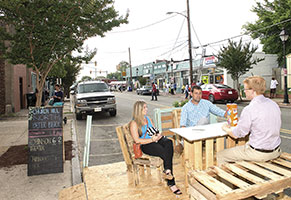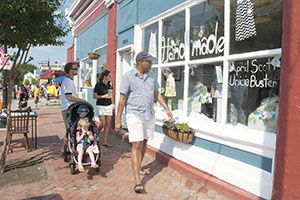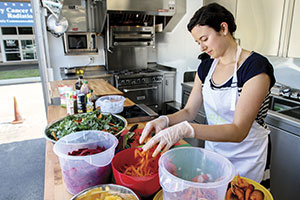By JULIE MINDA
During a two-day event earlier this summer in Richmond, Va., locals saw their sluggish East End community come alive, as they flocked by the hundreds to a "Better Block" street gathering sponsored in part by Bon Secours Richmond Health System.
One of the most recent of dozens of such "rapid revitalization" projects put on by an Oak Cliff, Texas-based urban planning team, the Better Block event in the East End engaged dozens of volunteers, retailers and organizations in quickly beautifying a several-block section of Richmond's faded East End, and establishing temporary pop-up businesses and activities. Residents and prospective investors turned out for two days of music, kids' activities, a 5K run, a walk, a movie screening, dining, socializing and shopping.
"It was high-energy," said David Belde, Bon Secours Richmond senior vice president of mission services. Throughout the June 13–14 event, "it was packed with people of all ages. This could be a game changer for this area. … The area is poised for growth."

Event goers relax in a temporary outdoor dining area for Miracles Coffee Shop, one of the pop-up businesses opened in conjunction with a Better Block revitalization event to spur economic development in Richmond's East End.
Bon Secours Richmond helped bring Better Block to Richmond to celebrate some progress made in recent years of economic development work and to illustrate to the city and to prospective investors that there is a real potential for the slumped East End community to rebound.
Look and listen
Jim Dunn, vice president of advocacy and community affairs for Bon Secours Richmond, said, "A lot of private sector developers kind of follow what's going on, and we had developers at our (event); and when they think something's about to get to the tipping point, then they jump in and say, 'Gee, this thing looks like it's gonna go, now we want a piece of this action, so we'll come in and start investing.'"
Nearly half of the people in the East End have an income below 200 percent of the poverty level, according to statistics from Bon Secours Richmond. Health data analysis shows high rates of obesity, hypertension and diabetes in the majority African-American community.
In 2010, Bon Secours Richmond held a series of charrettes, or public planning forums, in several of the communities its hospitals serve — its Bon Secours Richmond Community Hospital serves the East End. The East End sessions logged ideas and concerns voiced by residents, community leaders and planning experts. Belde said residents wanted grocery stores, a medical office building, a new library and a full-service fitness center.
Seed grants
Since the charrettes, Bon Secours Richmond has committed to acquiring property for a new health center, medical office building and women's center in the East End. It also has given out seed grants and microloans to entrepreneurs, including restaurateurs, to open businesses in the East End. It has created a jobs program for locals. And, it has been working with its partners to try to bring a new grocery store to the area and to get fresh fruits and vegetables on the shelves of the many convenience stores dotting the East End. Its partners in urban redevelopment have been working to better local housing stock and to repurpose an abandoned school.
But, revitalization has been happening in pockets in the East End, said Belde, and there are still large tracts of abandoned buildings and empty lots begging for improvement.
Belde and Dunn said the time is right to highlight the East End's huge potential for revitalization. Health system leaders decided to showcase the neighborhood using a quick revitalization approach called tactical urbanism. Tactical urbanism — a term coined by urban planner Mike Lydon of New York City's Street Plans Collaborative — involves a short burst of economic development that generates quick results to serve as a catalyst for greater change.
Stacks of plans
Bon Secours Richmond worked with urban planners Andrew Howard and Jason Roberts. The Texas duo's Team Better Block is an urban planning consultancy based in Oak Cliff. They created a prototype for rapid revitalization in economically depressed urban neighborhoods called Better Block. That Better Block blueprint is offered on the web in an "open source" format, with ideas available for free to any interested community or planner, who can also contribute their ideas.

Community members window shop at a pop-up store along the corridor beautified during the Better Block event in Richmond, Va.'s East End.
Roberts said he and his colleague developed the Better Block concept after taking part in town hall meetings on revitalization and realizing that struggling urban areas nationwide had "stacks of plans — many cities spend millions on planning and consultants but little is created, little is done to change the built environment."
He said Better Block helps stakeholders in struggling cities to identify issues that have contributed to decline and then to find quick ways to demonstrate potential so that people will be inspired to undertake deep-seated revitalization. "If we can show (short-term) economic improvement, and show the increased taxes from improvement, we can get the strongest buy-in. We go where things are broken, and fix what we can," Roberts said.
Pop-ups
In the early spring, a Better Block team held a community walk-through of the stretch of the East End that community leaders had identified as the most promising for revitalization. Consultants and locals discussed reasons people avoid the area — for instance, some people think the East End is unsafe — and they identified things that could be done in a few days to beautify the area and to attract pedestrians. Then, the Better Block team assisted in laying the groundwork, including working with the city to identify East End property owners who could participate and to obtain the needed permits.
During the days just prior to the June event, volunteers, businesses and participating organizations cleaned the blocks, painted storefronts, erected makeshift tables and chairs for sidewalk dining, designated bike paths and set up the pop-up businesses. Roberts said a key goal was to make the area look and feel safe again, so people would want to visit it during and after the event.
Bon Secours Richmond funded the Better Block team's involvement and other aspects of the event, because community improvement ties directly to better health outcomes, said Belde.
He noted that with any change, including urban redevelopment, comes community concerns. He said Bon Secours Richmond and its partners are working toward widespread neighborhood improvements that could increase property values and the cost of living in the area. Belde said Bon Secours Richmond is working to mitigate resident worries that East End development could lead to gentrification, and the pushing out of locals. Part of that involves close communication to hear and respond to residents' concerns. Belde said Bon Secours Richmond will support job training programs aimed at preparing End Enders for higher-wage jobs.
Dunn added that the community's support is essential to the long-term revitalization of the East End. "The community needs to take pride in new businesses when they come, and take ownership and protect those businesses. As new facilities come on line, the community needs to step up and support them."
Mobile kitchen gives Richmonders crash course in healthy eating
Bon Secours Richmond Health System and some local partners are working to make fresh, healthful food more available in low-income neighborhoods in Richmond, Va. But system leaders know the efforts will have no impact on health outcomes if residents don't actually eat the foods.
On the assumption that a mouthful of delicious food can go a long way in making the case for good eating habits, Bon Secours Richmond has unleashed the "Class-A-Roll," a 20-foot by 8-foot demonstration kitchen in a brightly wrapped trailer. Bon Secours Health System contributed about $135,000 over two years to outfit the kitchen and fund its outreach education programs.
The Class-A-Roll sets up at health and fitness events, housing complexes, churches, community centers, health centers, businesses and other venues to demonstrate to residents that healthful food can be tasty, affordable and easy to prepare. Now that school is starting, the kitchen will be dispatched to schools.
The mobile kitchen is part of a broader community benefit effort aimed at improving the health of Richmonders, and particularly those living in the low-income East End neighborhood, which encompasses about two and a half square miles.

Kelsey Plahn, community dietitian for Bon Secours Richmond Health System, prepares a meal in the Class-A-Roll mobile kitchen for her “Gardening Against Diabetes” presentation at Bon Secours Memorial Regional Medical Center in Mechanicsville, Va.
Many East End families cannot afford to make fresh fruits and vegetables and other wholesome foods mainstays of their diets. But even if they can afford it, many cannot easily stock up on fresh foods, according to Cynthia Newbille, a Richmond City Council member who represents the East End. According to a Bon Secours spokesperson, the only grocery store in Newbille's district does not stock fresh fruits and vegetables.
A trip to the grocery store may require several bus transfers, Newbille said. "So even if you're inclined to go, it's hard to get there, especially if you're traveling by bus with children. And, you can't carry a lot of food if you're taking the bus," she said.
Rachel Bulifant, a registered dietician who manages community nutrition for Bon Secours Richmond, noted that some experts are beginning to call neighborhoods like Richmond's East End "food swamps" — as opposed to food deserts — since the areas are swamped with convenience stores and fast food restaurants offering cheap, but unhealthy processed food.
The socioeconomic dynamics and the scarcity of healthy food have contributed to poor health outcomes in Richmond, and especially in the East End, according to Bulifant.
To help East Enders and their neighbors improve their eating habits and their health, Bon Secours Richmond partners with the city, the city's health department, local food growers and others to improve access to fresh produce. The "Healthy Corner Store" initiative puts fruits and vegetables from a local grower into convenience stores. A prescription produce plan provides healthy food at no cost to low-income people for 12 weeks and tracks the impact on their health measures. The partners brought farm stands to the East End.
But, according to Bulifant and Newbille, just having the healthy ingredients more readily available is not enough to change food preferences.
That's where the Class-A-Roll comes in. Bulifant, members of her staff and volunteer chefs demonstrate how to prepare quick and nutritious meals in the mobile kitchen. They get audiences excited about healthy foods.
The classes, Bulifant said, "are not just about how to cook. We're showing: This is a cucumber, this is how it tastes, and this is what you can do with it. It's a conversation meant to impact and influence food choices." Both Bulifant and Newbille believe the mobile kitchen has real potential to have an impact on people's eating choices in the East End and throughout Richmond.
"The challenge I see is that we need more Class-A-Rolls," said Newbille. "There are so many opportunities to use it."
| East End had prospered before its decline
According to a documentary video called "Passion for a Place" about Richmond, Va.'s East End, one of the East End's neighborhoods, Church Hill, is Richmond's oldest community. Church Hill, and the East End generally, burgeoned as the region's tobacco industry prospered. The East End had a bustling "main street," with retail, homes, theaters and churches. In the decades after World War II, as people became reliant on cars, the suburbs grew; and people fled Richmond's urban core, including the East End, according to the video documentary. Now the community of about 47,000 people is dominated by a public housing community. Many homes and businesses are boarded up. There are no full-service grocery stores and people no longer congregate along the main street. Bon Secours Richmond Health System leaders say they their efforts and the work of their partners and the community is starting to reverse the downward trend; and they hope that revitalization will continue. |
Copyright © 2014 by the Catholic Health Association
of the United States
For reprint permission, contact Betty Crosby
or call (314) 253-3477.